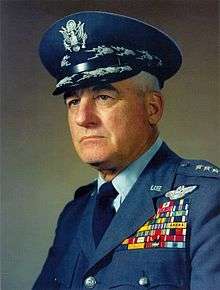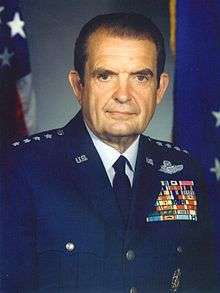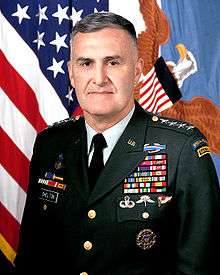Chairman of the Joint Chiefs of Staff
| Chairman of the Joint Chiefs of Staff | |
|---|---|
|
Seal of the Joint Chiefs of Staff | |
|
Flag of the Chairman of the Joint Chiefs of Staff | |
|
Department of Defense The Joint Staff | |
| Member of | Joint Chiefs of Staff |
| Reports to |
The President Secretary of Defense |
| Seat | The Pentagon, Arlington County, Virginia, U.S. |
| Nominator | Secretary of Defense |
| Appointer |
The President with Senate advice and consent |
| Term length |
2 years Renewable |
| Constituting instrument | 10 U.S.C. § 153 |
| Precursor | Chief of Staff to the Commander in Chief of the Army and Navy |
| Formation | August 19, 1949 |
| First holder | General of the Army Omar Bradley |
| Deputy |
Vice Chairman of the Joint Chiefs of Staff Director of the Joint Staff |
| Website |
www |
The Chairman of the Joint Chiefs of Staff (CJCS) is the highest-ranking military officer in the United States Armed Forces[2] and is the principal military advisor to the President, the National Security Council,[3] the Homeland Security Council,[3] and the Secretary of Defense.[3][4] While the Chairman of the Joint Chiefs of Staff outranks all other commissioned officers, he is prohibited by law from having operational command authority over the Armed Forces; however, the Chairman is permitted to assist the President and the Secretary of Defense in exercising their command functions.[2]
The Chairman convenes the meetings and coordinates the efforts of the Joint Chiefs of Staff (JCS), an advisory body within the Department of Defense comprising the Chairman, the Vice Chairman of the Joint Chiefs of Staff, the Chief of Staff of the Army, the Chief of Naval Operations, the Chief of Staff of the Air Force, the Commandant of the Marine Corps, and the Chief of the National Guard Bureau.[3] The post of a statutory and permanent Joint Chiefs of Staff chair was created by the 1949 amendments to the National Security Act of 1947. The 1986 Goldwater-Nichols Act elevated the Chairman from the first among equals to becoming the "principal military advisor" to the President and Secretary of Defense.
The Joint Staff, managed by the Director of the Joint Staff and consisting of military personnel from all the services, assists the Chairman in fulfilling his duties to the President and Secretary of Defense, and functions as a conduit and collector of information between the Chairman and the combatant commanders. The National Military Command Center (NMCC) is part of the Joint Staff operations directorate (J-3).
Although the office of Chairman of the Joint Chiefs of Staff is considered very important and highly prestigious, neither the Chairman, the Vice Chairman, nor the Joint Chiefs of Staff as a body has any command authority over combatant forces. The Goldwater-Nichols Act places the chain of command from the President to the Secretary of Defense directly to the commanders of the Unified Combatant Commands.[5] However the services chiefs do have authority over personnel assignments and oversight over resources and personnel allocated to the combatant commands within their respective services (derived from the service secretaries).
The Chairman may also transmit communications to the combatant commanders from the President and Secretary of Defense[6] as well as allocate additional funding to the combatant commanders if necessary.[7] He also performs all other functions prescribed under 10 U.S.C. § 153 or allocates those duties and responsibilities to other officers in the joint staff under his name.
Department of Defense Directive 5100.01, issued by the Secretary of Defense, describes the organizational relationships within the Department of Defense (DoD), and is the principal directive for delineating the major functions of organizations and entities within the Department, including those of the Chairman of the Joint Chiefs of Staff and organizations under the Chairman.[8][9]
Organization and assistants
The principal deputy to the Chairman is the Vice Chairman of the Joint Chiefs of Staff (VCJCS), another 4-star general or admiral, who among many duties chair the Joint Requirements Oversight Council (JROC).
The Chairman of the Joint Chiefs of Staff is assisted by the Joint Staff, led by the Director of the Joint Staff, a three-star general or admiral. The Joint Staff is an organization composed of approximately equal numbers of officers contributed by the Army, Navy, Marine Corps and Air Force, who have been assigned to assist the Chairman with the unified strategic direction, operation, and integration of the combatant land, naval, and air forces. The National Military Command Center (NMCC) is part of the Joint Staff operations directorate (J-3).
The Chairman of the Joint Chiefs of Staff is also advised on enlisted personnel matters by the Senior Enlisted Advisor to the Chairman, who serves as a communication conduit between the Chairman and the senior enlisted advisors (command sergeants major, command master chief petty officers, and command chief master sergeants) of the combatant commands.
Historical
Fleet Admiral William D. Leahy, USN, served as the Chief of Staff to the Commander in Chief from July 20, 1942 to March 21, 1949. He presided over meetings of what was called the Joint Chiefs of Staff,[10] and Leahy's office was the precursor to the post of Chairman of the Joint Chiefs of Staff, created in 1942.
Appointment and rank
The Chairman is nominated by the President for appointment and must be confirmed via majority vote by the Senate.[2] The Chairman and Vice Chairman may not be members of the same armed force service branch.[11] However, the President may waive that restriction for a limited period of time in order to provide for the orderly transition of officers appointed to serve in those positions.[11] The Chairman serves a two-year term of office at the pleasure of the President,[2] but can be reappointed to serve two additional terms for a total of six years, as long as the Chairman has not previously served a term as Vice Chairman,[2] in which case the Chairman would be limited to serving up to two terms.[2] However, in a time of war or national emergency, there is no limit to how many times an officer can be reappointed to serve as Chairman.[2] Historically, the Chairman has served two terms. By statute, the Chairman is appointed as a four-star general or admiral while holding office[2] and assumes office on October 1 of odd-numbered years.[2]
Although the first Chairman of the Joint Chiefs of Staff, Omar Bradley, was eventually awarded a fifth star, the CJCS does not receive one by right, and Bradley's award was so that his subordinate, General of the Army Douglas MacArthur, would not outrank him.[12][13]
In the 1990s, there were proposals in U.S. Department of Defense academic circles to bestow on the office of Chairman of the Joint Chiefs of Staff a five-star rank.[14][15][16]
According to the 2015 Military Pay Table effective 1 January 2015, while serving as Chairman, Joint Chief of Staff/Vice Chairman, Joint Chief of Staff, Chief of Navy Operations, Commandant of the Marine Corps, Army/Air Force Chief of Staff, Commander of a unified or specified combatant command, basic pay is $21,147.30 monthly plus additional allowances. All pay for flag officers, however, is limited by Level II of the Executive Schedule which is $15,125.10.[17]
List of Chairmen
Chief of Staff to the Commander in Chief (historical predecessor office)
| No. | Image | Name | Branch | Term of Office | Secretaries | President | ||
|---|---|---|---|---|---|---|---|---|
| Began | Ended | Days of Service | ||||||
| 1. |  |
Fleet Admiral William D. Leahy | USN | July 20, 1942 | March 21, 1949 | 2436 | Henry L. Stimson, Robert P. Patterson, Kenneth C. Royall, of War; Frank Knox of Navy James V. Forrestal 1st DOD | Franklin D. Roosevelt Harry S. Truman |
Chairmen of the Joint Chiefs of Staff
Chairmen of the Joint Chiefs of Staff by branches of service

- Air Force - 4
- Army - 9
- Marine Corps - 2
- Navy - 4
See also
- Chief of Defence
- List of United States Chairmen of the Joint Chiefs of Staff by time in office
- National Command Authority
- National Military Strategy (United States)
- Single Integrated Operational Plan
- Unified Command Plan
References
- Department of Defense Directive 5100.1: Functions of the Department of Defense and Its Major Components (PDF). Department of Defense Directive. Washington, D.C.: U.S. Department of Defense. 2010-12-21.
- "Department of Defense Directive 5100.01 Functions of the Department of Defense and Its Major Components". Office of the Secretary Defense, Director of Administration and Management, Directorate for Organizational & Management Planning. Retrieved 13 June 2013.
- 1 2 General Joseph F. Dunford, Jr.- Chairman, Joint Chiefs of Staff
- 1 2 3 4 5 6 7 8 9 10 USC 152. Chairman: appointment; grade and rank
- 1 2 3 4 10 USC 151. Joint Chiefs of Staff: composition; functions
- ↑ Goldwater-Nichols Act of 1986
- ↑ 10 USC 162. Combatant commands: assigned forces; chain of command
- ↑ 10 USC 163. Role of Chairman of Joint Chiefs of Staff
- ↑ 10 USC 166a. Combatant commands: funding through the Chairman of Joint Chiefs of Staff
- ↑ Department of Defense Directive 5100.01 Functions of the Department of Defense and Its Major Components
- ↑ DoDD 5100.1: p.1.
- ↑ "Washington Eats". Life. 1942-10-05. p. 95. Retrieved November 20, 2011.
- 1 2 10 USC 154. Vice Chairman
- ↑ Abrams, Jim (March 22, 1991). "Higher rank not in the stars for nation's top generals". Associated Press.
Bradley received his fifth star in 1950 when he became chairman of the Joint Chiefs of Staff so he would not be outranked by MacArthur.
- ↑ Tillman, Barrett (2004). Brassey's D-Day encyclopedia: the Normandy invasion A-Z. Brassey's. p. 48. ISBN 978-1-57488-760-0. Retrieved February 22, 2011.
MacArthur, having been army chief of staff before World War II, was senior to everyone on the Joint Chiefs, and some observers felt that Bradley was given his fifth star in order to deal with the vainglorious field commander on an equal footing.
- ↑ Organizing for National Security: The Role of the Joint Chiefs of Staff. Institute for Foreign Analysis. January 1986. p. 11. Retrieved February 21, 2011.
There was some discussion of the proposal to grant the Chairman of the Joint Chiefs five-star rank, as a symbol of his status as the most senior officer in the armed forces.
- ↑ Jones, Logan (February 2000). "Toward the Valued Idea of Jointness: The Need for Unity of Command in U.S. Armed Forces" (PDF). Naval War College: 2. ADA378445. Retrieved February 21, 2011. Lay summary.
Promoting the Chairman to the five-star rank and ceding to him operational and administrative control of all U.S. Armed Forces would enable him to provide a unifying vision...
- ↑ Owsley, Robert Clark (June 1997). "Goldwater-Nichols Almost Got It Right: A Fifth Star for the Chairman" (PDF). Naval War College: 14. ADA328220. Retrieved February 21, 2011. Lay summary.
...Chairman's title be changed to Commander of the Armed Forces and commensurate with the title and authority he be assigned the grade of five stars.
- ↑ http://www.dfas.mil/militarymembers/payentitlements/military-pay-charts.html
External links
| Wikimedia Commons has media related to Chairman of the Joint Chiefs of Staff. |
| ||||||||||
| ||||||||
| ||||||||
| ||||||||||||||||||||||||||||||||||||||||||||||||||||||||||||||||||||||||||||||||||||












